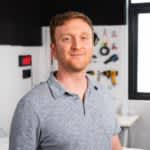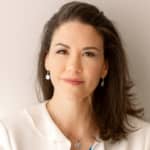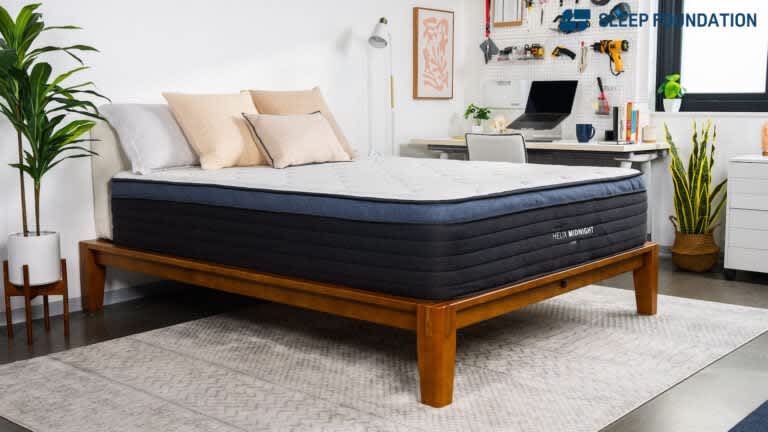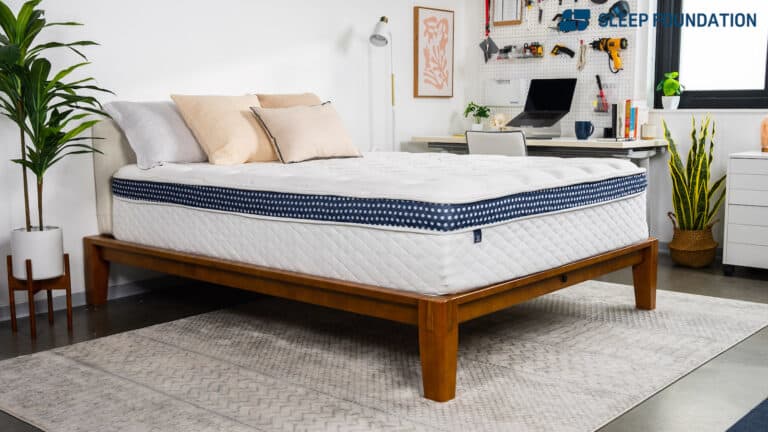When you buy through our links, we may earn a commission. Products or services may be offered by an affiliated entity. Learn more.
Let us help you find the perfect bed
Fibromyalgia is a condition that can contribute to widespread musculoskeletal pain and temperature sensitivity, which in turn, may cause poor sleep. People with fibromyalgia may experience other sleep problems such as interrupted sleep, lack of restorative sleep, and/or insomnia. The condition also frequently co-exists with sleep apnea and restless leg syndrome. While you should consult a doctor about treating fibromyalgia, a supportive, comfortable mattress can promote quality sleep.
Our Top Picks
-
Best Mattress Overall – Helix Midnight Luxe
View Details
-
Most Comfortable Mattress – Luxury Firm WinkBed
View Details
-
Best Luxury Mattress – Saatva Rx
View Details
-
Best Mattress for Back Pain – Bear Elite Hybrid
View Details
Swipe for more
Best Mattress Overall
Helix Midnight Luxe
9.7 /10
Test Lab Score
25% off sitewide
25% off sitewide
The Helix Midnight Luxe is ideal for many side sleepers with fibromyalgia, offering a thoughtful blend of plush memory foam and zoned lumbar support. This design alleviates pressure points, enhances spinal alignment, and promotes air circulation to relieve discomfort while maintaining a neutral temperature.
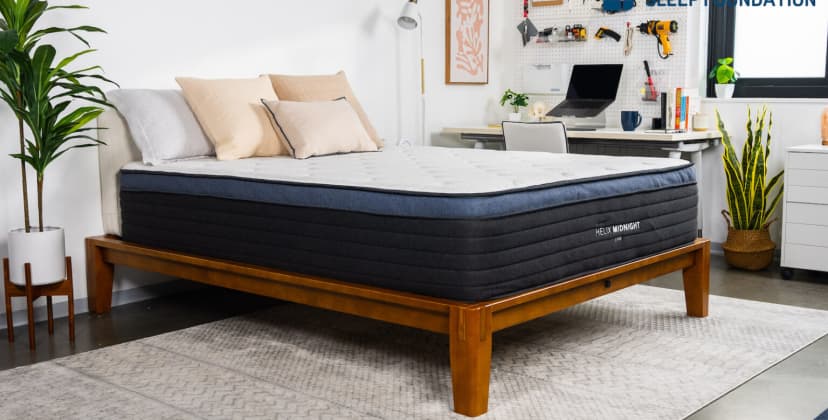
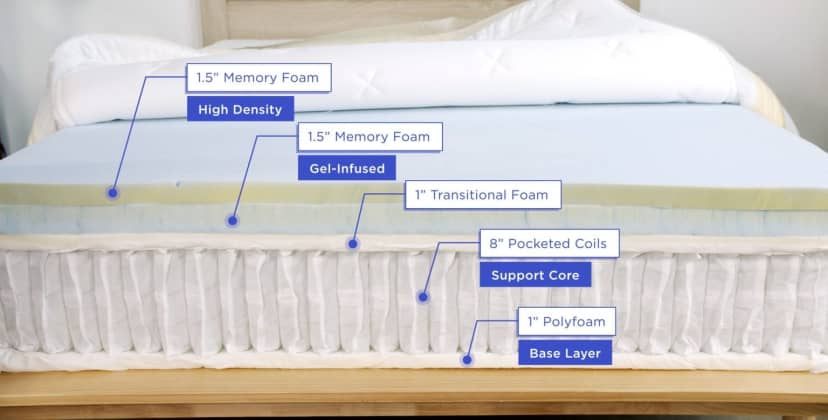
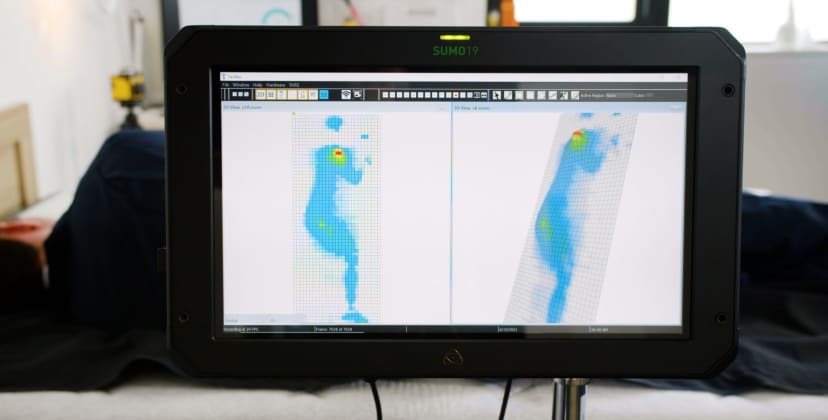
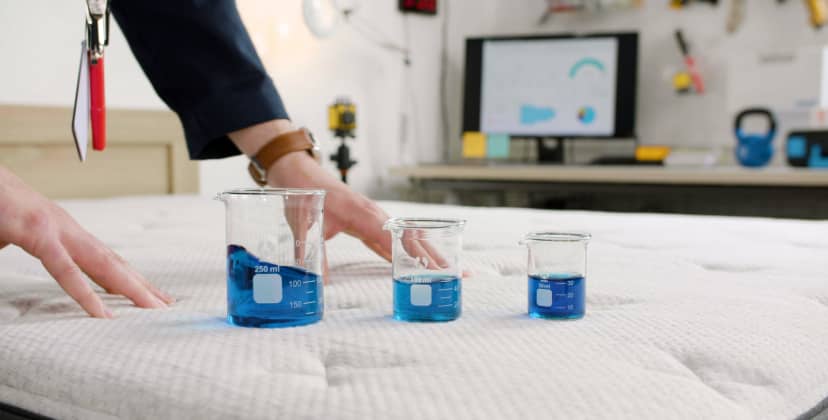
Credit: Sleep Foundation Test Lab
Price
$1,799
Mattress Type
Hybrid
Firmness Options
Medium Firm (6)
Trial Period
120 nights (30-night requirement)
At a Glance
- Who It’s Best For: Side sleepers between 130 and 230 pounds.
- Feel: Cushioning pillow-top and close-conforming memory foam for a plush yet supportive feel. Cool surface and breathable construction.
- What It’s Made Of: A three-layer comfort system with two layers of polyfoam and one layer of copper-infused memory foam. A zoned pocketed coil core and a final polyfoam base layer. Cover is Tencel.
- What We Don’t Like: Stomach sleepers may sink in deeply.
Scoring & Reviews
The following ratings show how suitable this mattress is for different sleeping positions and sleeper weights. These scores are determined by how well the mattress supports and relieves pressure for each sleeper type.
We performed a meta-analysis on 5876 validated customer reviews of the Helix Midnight Luxe. This is what people who bought the mattress had to say:- Comfort and Support: Many reviewers express that the mattress provides exceptional comfort and support, especially noting its ability to alleviate back, hip, and shoulder pain.
- Sleep Quality Improvement: The mattress is frequently described as transformative for those who previously struggled with sleep disturbances.
- Temperature Regulation: Positive remarks are made about the cooling properties of the mattress. Users find the cooling aspect effective, helping to maintain a comfortable sleeping temperature throughout the night.
- Customer Service: Experiences with customer service are predominantly positive, with buyers appreciating the responsive and helpful nature of the support team. Issues are resolved satisfactorily, contributing to a positive overall customer experience.
- Durability Concerns: A few reviewers express concerns about the mattress showing signs of wear or sagging prematurely. These concerns are not widespread but are significant enough to be noted by potential buyers.
- Mixed Reviews on Firmness: While many find the mattress perfectly balanced, there are mixed reviews regarding its firmness. Some users find it softer than expected given its firmness level. While the ‘medium firm’ rating is appropriate by our measurements, the bed does have a ‘cushy’ foam feel that makes for a fairly soft surface feel.
Full Details
The Midnight Luxe is part of Helix Sleep’s luxury pillow-top hybrid line. While all Luxe models have their strong points, the Midnight Luxe has a balanced medium firm (6) feel that caters to the needs and preferences of most side sleepers up to 230 pounds.
How It Performs
Airflow through the pocketed coils helps keep the bed cool. The coils are also zoned to reinforce the edges against sinkage and provide enhanced support for the torso, hips, and other areas where people tend to carry more weight.
The contouring comfort layer combined with the supportive coils make this a good fit for sleepers who weigh up to 230 pounds. Side and back sleepers should find the mattress particularly comfortable.
Construction Breakdown
A breathable, silky-soft Tencel cover encases the mattress. The quilted pillow-top followed by a comfort layer of soft foam creates a plush feel for the surface. The second comfort layer is also composed of memory foam, so you should expect some noticeable contouring and slow response from this mattress.
The third layer consists of transitional polyfoam for added conforming and support. The support core features pocketed coils that deliver bounce while limiting motion transfer. The Midnight Luxe’s support core also contains a base layer of dense polyfoam.
Trial, Shipping & Warranty
Shipping is free for customers in all 50 states. There’s a 120-night sleep trial and a lifetime warranty.
Best Value Mattress
Brooklyn Bedding CopperFlex Memory Foam
8.6 /10
Test Lab Score
30% off sitewide
30% off sitewide
The Brooklyn Bedding CopperFlex alleviates pain and pressure, resists heat buildup, and prevents your midsection from sinking too deeply – all important mattress qualities if you live with fibromyalgia. An affordable sticker price sweetens the deal for budget-conscious shoppers.

Credit: Sleep Foundation Test Lab
Price
$466
Mattress Type
Foam
Firmness Options
Medium Firm (6)
Trial Period
120 nights (30-night requirement)
At a Glance
- Who It’s Best For: Side sleepers at least 130 pounds and back sleepers up to 230 pounds, as well as couples.
- Feel: Medium firm (6) with some plushness and body-contouring but transitional and base layers offer pushback. Top layer helps draw heat away from your body.
- What It’s Made Of
- Comfort system of adaptive polyfoam sewn to the cover, two memory foam layers, and three-zone transitional polyfoam. Top memory foam layer has a copper infusion and the cover is GlacioTex cooling fabric. Support core is two layers of high-density polyfoam.
- What We Don’t Like: Strong initial odor for up to 72 hours after unboxing. Too soft for stomach sleepers 130 pounds or more.
Scoring Breakdown
The following ratings show how suitable this mattress is for different sleeping positions and sleeper weights. These scores are determined by how well the mattress supports and relieves pressure for each sleeper type.
We performed a meta-analysis on 549 validated customer reviews of the Brooklyn Bedding CopperFlex Memory Foam. This is what people who bought the mattress had to say:- Pricing and Value: Many reviewers have highlighted that the mattress is affordable and offers great value for the price, making it an excellent choice for budget-conscious shoppers.
- Heat Regulation: Several users noted that the mattress does not retain much heat, which contributes to a cooler and more comfortable sleep, especially for those who tend to sleep hot.
- Edge Support: The mattress is reported to have good edge support, which is beneficial for those who use the edge of the bed frequently or sleep close to the sides.
- Odor and Off-Gassing: Some reviews mention that the mattress has minimal off-gassing odor upon unpacking, which is a common concern with new mattresses. The smell will dissipate in a few days.
- Hybrid Option: The availability of hybrid models is appreciated, particularly for those needing more support, such as individuals with larger frames.
- Customer Service: Positive remarks about customer service suggest that the company handles queries and issues effectively.
Full Details
Brooklyn Bedding’s CopperFlex Memory Foam is both high-quality and budget-friendly — a rare combination in today’s mattress market. Composed of six individual foam layers, the CopperFlex offers plush cushioning on the surface and sturdy underlying support. This design helps ensure relief for your pressure points and sore spots without too much sinkage beneath your midsection.
How It Performs
Most of our testing team awarded positive ratings to the CopperFlex. The highest marks came from side sleepers of at least 130 pounds and back sleepers up to 230 pounds. Stomach sleepers on our team under 130 pounds also found the mattress comfortable. Despite a close contour from the comfort layers, the zoned transitional foam and dense base layers stabilize the mattress to push back against your weight and maintain a flat surface for your body.
We observed excellent motion isolation during our tests. All six foam layers work together to absorb movements on each side of the mattress and prevent motion from transferring elsewhere, so you and your partner shouldn’t wake each other up with position changes or trips to the bathroom during the night. Other standout qualities we noticed during performance tests include above-average temperature control and consistent pain and pressure relief.
Construction Breakdown
The CopperFlex’s topmost layer consists of adaptive polyflam quilted to the cover. Two memory foam layers add deep cushioning and contouring to the comfort system, the first of which is infused with copper fibers to increase cooling and reduce heat buildup on the surface. The transitional foam is divided into three zones to maximize support beneath your midsection and gently cradle lighter areas of your body. Two high-density foam layers make up the support system, and the cover is made of proprietary GlacioTex fabric engineered to capture and release body heat when it comes into contact with your skin.
Trial, Shipping & Warranty
Ground shipping is free within the contiguous U.S. Each order comes with a 120-night sleep trial. If you keep the mattress, your purchase is backed by a lifetime warranty against manufacturing defects.
Most Comfortable Mattress
Luxury Firm WinkBed
9.5 /10
Test Lab Score
Get $300 off all mattresses at Winkbeds
Get $300 off all mattresses at Winkbeds
The Luxury Firm WinkBed ticks most of the boxes for sleepers with fibromyalgia. Its polyfoam Euro-top cushions the surface to reduce pressure-related discomfort, and a zoned coil core promotes spinal alignment. Meanwhile, advanced temperature control and superior airflow help prevent overheating.
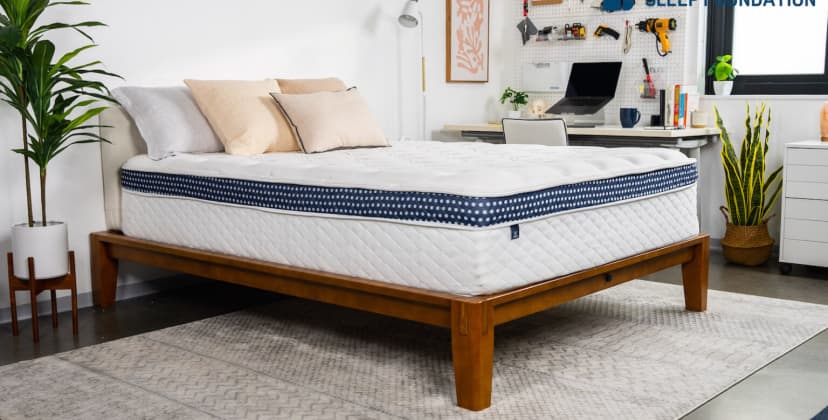
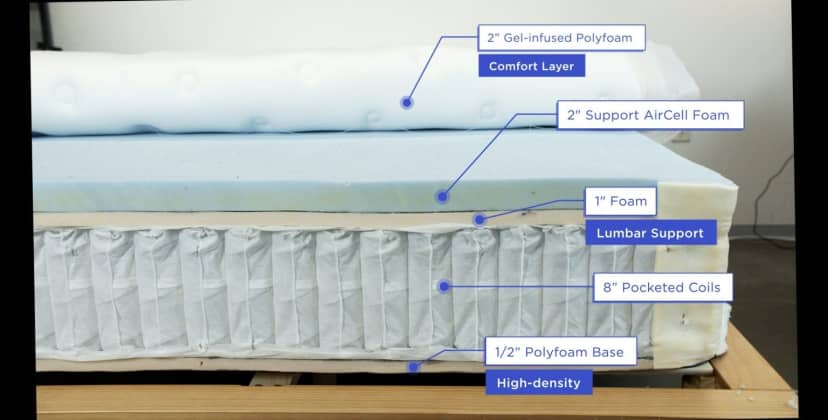
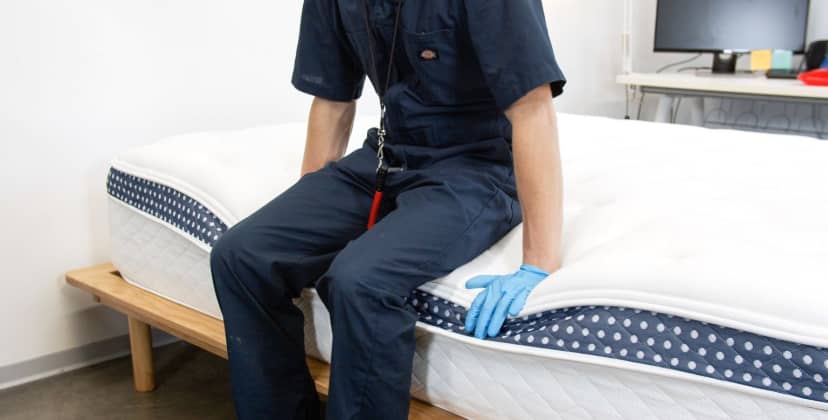
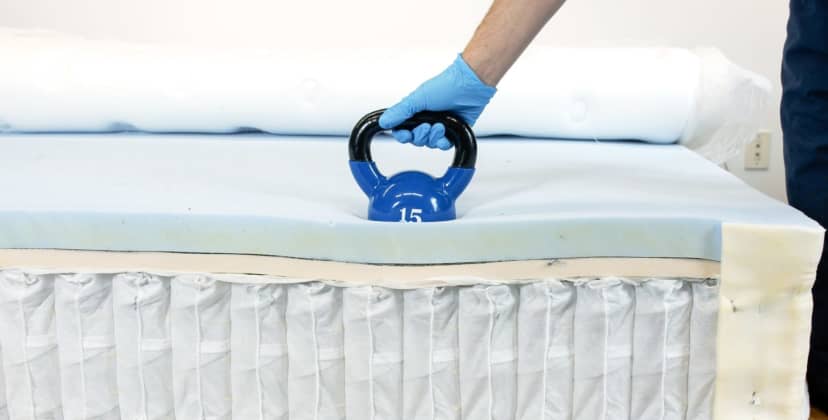
Credit: Sleep Foundation Test Lab
Price
$2,570
Mattress Type
Innerspring
Firmness Options
Medium Firm (6)
Trial Period
120 nights (30 night requirement)
At a Glance
- Who It’s Best For: Side sleepers.
- Feel: Medium firm (6) feel and hybrid design. Combines bounce, breathability, and pressure relief. Gentle hugging sensation that doesn’t restrict airflow or movement.
- What It’s Made Of: Two layers of gel-infused polyfoam quilted into a Euro-top cover, followed by another layer of polyfoam. Zoned coil core and a reinforced perimeter. The cover is Tencel.
- What We Don’t Like: May notice movement.
Scoring & Reviews
The following ratings show how suitable this mattress is for different sleeping positions and sleeper weights. These scores are determined by how well the mattress supports and relieves pressure for each sleeper type.
We performed a meta-analysis on 8573 validated customer reviews of the Winkbed. This is what people who bought the mattress had to say:- Quality of Materials: The mattress is frequently described as well-made, with durable materials that contribute to a good night’s sleep.
- Cooling Features: Some reviewers mention that the mattress does a good job of regulating temperature, providing a cooler sleep experience.
- Edge Support: While generally satisfied with the support, a few reviewers note that edge support could be better.
- Comfort and Support: Many reviewers praise the mattress for its comfort and support, often mentioning relief from back pain and improved sleep quality.
- Firmness Options: Customers appreciate the variety of firmness options available, finding the right balance for their personal preferences.
- Value for Money: Many users feel the mattress is worth the investment, offering good value for the quality and comfort provided.
- Made in the USA: Buyers are pleased that the mattresses are made in the USA, supporting domestic manufacturing.
Full Details
The Luxury Firm WinkBed is a hybrid mattress that offers strong support as well as comfort. It provides targeted support to promote spinal alignment, making it well-suited for people who experience back pain. Since patients with fibromyalgia may already be suffering from musculoskeletal pain, they can benefit from a mattress that helps reduce any additional pain in the body.
How It Performs
Our team found the mattress best suited back and stomach sleepers who weigh up to 230 pounds. Side sleepers who are between 130 and 230 pounds should find the feel comfortable as well. The mattress’ polyfoam layers are more responsive than hybrid mattresses with memory foam comfort systems. This responsiveness enables sleepers to move around more easily on the contouring foam layer without sinking too far in.
The foam comfort system, coupled with the pocketed coils in the support core, also offer excellent motion isolation. People who share a bed with restless sleepers may benefit from this feature. While traditional foam mattresses tend to trap heat, this model’s foam layer is infused with gel, which makes the foam more breathable for hot sleepers. The coils also help circulate air and the Tencel cover adds to the mattress’ breathability.
Construction Breakdown
The comfort system contains a gel-infused foam pillow-top over a layer of denser proprietary SupportCell polyfoam. Beneath this is a support core comprised of pocketed coils. The Euro-top offers softness and contouring that helps relieve various pressure points on the body, while the SupportCell foam evenly distributes weight and prevents sinkage. The pocketed coils are zoned to offer targeted support that promotes proper alignment of the back, hips, and shoulders, making the mattress an option for sleepers who experience back pain. The edge is reinforced with thick coils to help prevent sagging over time. A moisture-wicking Tencel cover encases the mattress.
Trial, Shipping & Warranty
Shipping and returns are free. A 120-night trial period is available, and mattress purchases come with a lifetime warranty.
Best Mattress for Side Sleepers
Leesa Sapira Chill Hybrid
9.0 /10
Test Lab Score
25% off sitewide
25% off sitewide
The Leesa Sapira Chill Hybrid strikes a nice balance of light cushioning for your sore spots, strong multi-zoned support, and responsiveness to movement. You can choose from three firmness levels based on your sleep position, body type, and personal preferences.
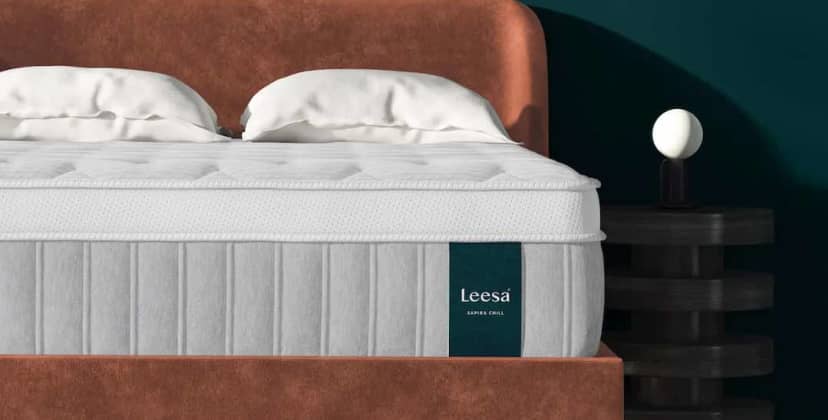
Credit: Sleep Foundation Test Lab
Price
$1,698
Mattress Type
Hybrid
Firmness Options
Medium (5), Medium Firm (6), Firm (7)
Trial Period
120 nights (30-night requirement)
At a Glance
- Who It’s Best For: Side, back, and stomach sleepers across most weight groups – especially those with frequent pain or pressure points.
- Feel: Available in medium (5), medium firm (6), and firm (6) designs.
- What It’s Made Of: Comfort layers of adaptive polyfoam and memory foam encased in a Euro-top cover, followed by zoned pocketed coils with perimeter reinforcement and high-density base foam.
- What We Don’t Like: Initial off-gassing odor can be strong for up to 72 hours after the mattress is unboxed.
Scoring & Reviews
The following ratings show how suitable this mattress is for different sleeping positions and sleeper weights. These scores are determined by how well the mattress supports and relieves pressure for each sleeper type.
We performed a meta-analysis on 25 validated customer reviews of the Leesa Sapira Chill Hybrid. This is what people who bought the mattress had to say:- Suitability for Different Sleepers: Several reviews highlight that the mattress is suitable for side sleepers, stomach sleepers, and even for those who experience hip and shoulder pain.
- Temperature Regulation: Some reviews mention the mattress being cool and comfortable, while others complain about it sleeping hot, despite being the “Chill” version.
- Quality and Durability Concerns: A few reviewers express concerns about the mattress’s durability or mention receiving a damaged product.
- Overall Satisfaction: While many reviews are overwhelmingly positive, scoring 5 out of 5, there are a few lower scores where users mention issues like the mattress being too soft, too bouncy, or not meeting expectations in terms of firmness and comfort.
- Specific Needs: Some reviews from users with back pain or who have had long-term use of other mattresses indicate that this model significantly improved their sleep quality and comfort.
Full Details
A comfortable night’s sleep can be elusive for people living with fibromyalgia, but the Leesa Sapira Chill Hybrid is thoughtfully designed to help alleviate many symptoms of this medical condition. A thick comfort system with four individual foam layers helps to ensure a soothing, adaptive surface, while zoned coils support your midsection to reduce pain and pressure buildup in your shoulders, lower back, and hips.
How It Performs
Our team tested each of the Sapira Chill Hybrid’s three firmness levels. The medium (5) design earned its highest ratings from side and back sleepers under 130 pounds, while the firm (7) model was most popular among back and stomach sleepers over 230 pounds. The majority of our team agreed the medium firm (6) design was most comfortable, noting the balance of gentle cushioning, sturdy reinforcement, bounce, and cooling. Testers between 130 and 230 pounds were particularly impressed with this model.
Temperature regulation proved to be one of the Sapira Chill Hybrid’s defining strengths. Despite the thick foam layers, this mattress absorbs very little body heat and should be a solid match for people who run warm while they sleep. We also found the hybrid isolates motion well and alleviates pressure – two performance factors that are often lacking in coil mattresses.
Construction Breakdown
The Sapira Chill Hybrid’s comfort system begins with 2 inches of adaptive polyfoam sewn to the Euro-top cover. Additional memory foam and polyfoam comfort layers provide deep cushioning and contouring, while transitional foam pushes back against your body to keep you on an even plane.
Pocketed coils and high-density base foam make up the support core. The coils are zoned to feel sturdier beneath your torso and hips, and reinforced along the perimeter to bolster the edges when you get in and out of bed. At 14 inches, the Sapira Chill Hybrid is on the thicker side, so you will need to invest in a deep-pocket fitted sheet.
Trial, Shipping, and Warranty
Leesa is one of the few online mattress companies to offer free shipping to all 50 states. Select locations in Canada also qualify for free delivery. The Sapira Chill Hybrid comes with a 120-night sleep trial. If you decide to keep the mattress after the return period ends, your purchase is also covered under a lifetime manufacturer’s warranty.
Best Luxury Mattress
Saatva Rx
8.5 /10
Test Lab Score
$300 off orders of $1,000 or more
$300 off orders of $1,000 or more
The Saatva RX is a luxury model specifically designed for individuals with chronic pain conditions. Offering a refined blend of pressure relief and support, its advanced construction is engineered to ease pain by promoting spinal alignment and reducing joint stress caused by pressure points.

Credit: Sleep Foundation Test Lab
Price
$2,801
Mattress Type
Hybrid
Firmness Options
Medium Soft (4)
Trial Period
365 Nights ($99 Return Fee)
At a Glance
- Who It’s Best For
- Side sleepers with fibromyalgia.
- Feel: Medium soft (4) with a gentle, cradling sensation, which relieves pressure while supporting the spine. Surface maintains a relatively neutral temperature.
- What It’s Made Of: Comfort system includes memory foam, polyfoam, and microcoils. The core includes 8 inches of pocketed coils topped with 2-inch polyfoam modules. The cover is cotton.
- What We Don’t Like: Movement difficult for some sleepers. Back and stomach sleepers might sink in too deeply.
Scoring & Reviews
The following ratings show how suitable this mattress is for different sleeping positions and sleeper weights. These scores are determined by how well the mattress supports and relieves pressure for each sleeper type.
We performed a meta-analysis on 40 validated customer reviews of the Saatva Rx. This is what people who bought the mattress had to say:- Comfort and Support: A significant number of reviewers mentioned the comfort and support provided by the Saatva Rx mattress, particularly for those with chronic pain or orthopedic issues. Users reported significant improvements in sleep quality and reductions in pain.
- Product Quality: Feedback on the quality of the Saatva Rx mattress was overwhelmingly positive. Reviewers felt that the mattress was well-made and worth the investment, often citing the materials and construction as superior to other brands.
- Temperature Regulation: Some reviewers appreciated the temperature regulation features of the mattress, noting that it stayed cooler than other mattresses they had used, which contributed to a better sleep experience.
- Issues with Firmness and Support: While most feedback was positive, a few reviewers noted issues with the firmness and support of the mattress, particularly concerning edge support and suitability for lighter individuals. These were minor compared to the overall positive feedback but were important for some buyers’ comfort.
- Return and Exchange Policy: Saatva’s return and exchange policy was frequently mentioned as a positive aspect, with customers feeling reassured by the ability to return or exchange the mattress if it did not meet their needs. This policy enhanced customer confidence in making a purchase.
Full Details
The Rx is one of the newest additions to Saatva’s mattress lineup, and the brand’s first model specifically designed for people with chronic pain. Although the mattress is medium soft (4) and contours very closely, the coil-on-coil support system helped maintain an even surface with minimal sinkage for side and back sleepers on our team weighing up to 230 pounds.
How It Performs
During hands-on tests, the Rx earned praise from most side sleepers on our team. The mattress received particularly favorable ratings from side sleepers weighing up to 230 pounds, all of whom felt plenty of cushioning beneath their shoulders and hips — two common areas of pressure buildup for people who use this position.
Back and stomach sleepers under 130 pounds also felt comfortable on the Rx, but those who weigh more experienced deep sinkage. We generally recommend firmer mattresses for back and stomach sleepers weighing 130 pounds or more.
Motion isolation was a major testing highlight because most hybrids underperform in this category. The Rx’s soft feel and thick cushioning layers absorb movement well, and most of us felt little to no motion transfer when lying side by side with another tester. Temperature control was another strength. Both coil layers promote steady airflow, and the cover is exceptionally breathable.
Construction Breakdown
The Rx begins with a memory foam pad that rests directly beneath your lower back. This feature is intended to cushion the lumbar region and prevent pressure from building up at the base of your spine. Minicoils encased in dense foam create a transitional layer that adds to the mattress’ plush feel while serving as a sturdy buffer between your body and the support core.
The Rx’s pocketed coils are unique because each one is topped with a 2-inch foam disc. This helps suppress motion transfer and minimize nighttime disruptions for couples, and also prevents the mattress from feeling too stiff. Each disc is infused with graphite and phase change material to promote breathability and heat dissipation.
Thicker coils line the perimeter to stabilize the edges when you get in and out of bed, though you still may notice some sinkage. The cover is made of organic cotton. At 15 inches thick, the Rx is a high-profile mattress and may require a deep-pocket fitted sheet.
Trial, Shipping & Warranty
Saatva provides free White Glove delivery for each order, which includes full in-home setup and removal of your old mattress upon request. Your purchase also comes with a 365-night sleep trial, and those who keep their mattress receive a lifetime warranty against structural defects.
Best Mattress for Pressure Relief
Nolah Evolution 15
9.2 /10
Test Lab Score
35% off sitewide + extra $100 off with code: SF100
35% off sitewide + extra $100 off with code: SF100
The Nolah Evolution 15 is a hybrid model built for responsive pressure relief. A generous polyfoam comfort system and a zoned pocketed coil core redistribute weight while supporting the spine to ease discomfort. With three firmness options to choose from, most sleepers with fibromyalgia can find a version of the bed that provides a comfortable level of cradling for their sleep position and body type.

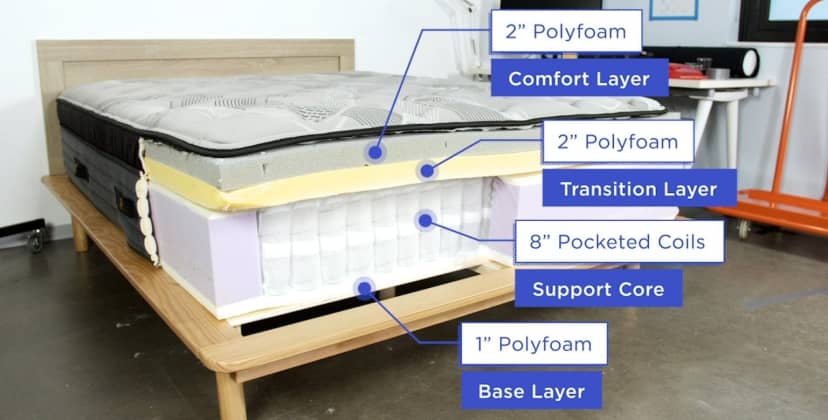
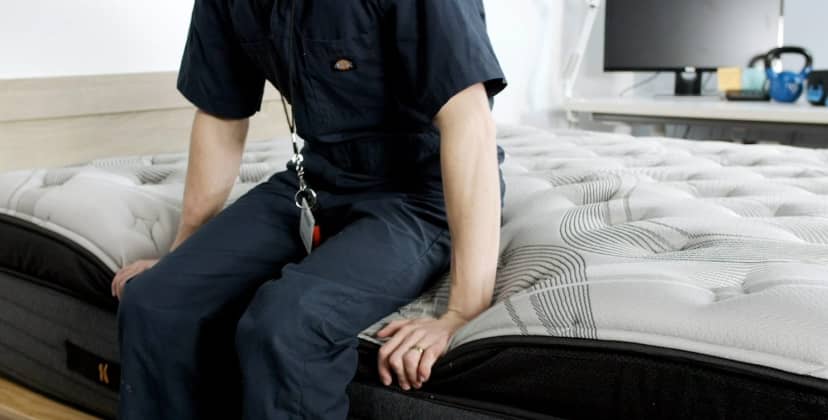
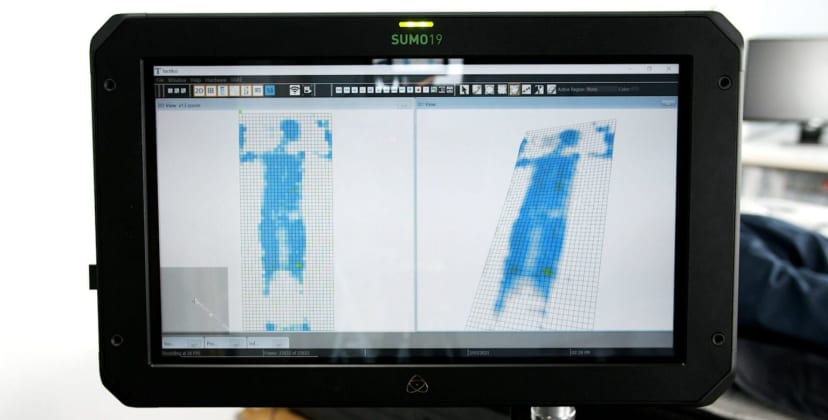
Credit: Sleep Foundation Test Lab
Price
$1,624
Mattress Type
Hybrid
Firmness Options
Medium (5), Medium Firm (6), Firm (8)
Trial Period
120 nights (30-night requirement), $99 return pickup fee
At a Glance
- Who It’s Best For: Those who prioritize pressure relief without sacrificing temperature neutrality.
- Feel: Plush yet supportive. Cushions and relieves pressure from sensitive areas, while adapting to the body for buoyant cradling.
- What It’s Made Of: Euro-top consisting of 2 inches of polyfoam quilted into a cotton cover, followed by another three layers of polyfoam. Base is zoned pocketed coils rest on top of polyfoam.
- What We Don’t Like: Initial odor. May be difficult for some sleepers to get into or out of depending on bed-frame height.
Scoring & Reviews
The following ratings show how suitable this mattress is for different sleeping positions and sleeper weights. These scores are determined by how well the mattress supports and relieves pressure for each sleeper type.
We performed a meta-analysis on 897 validated customer reviews of the Nolah Evolution 15. This is what people who bought the mattress had to say:- Motion Isolation: Couples note the excellent motion isolation, which minimizes disruptions from partner movements during the night.
- Edge Support: The edge support of the mattress is frequently highlighted, with many finding it adequate for sitting or sleeping near the edge without feeling like they will roll off.
- Softness: Many reviewers discuss the softness of the mattress. Some find it too soft, causing discomfort, especially for heavier individuals, while others appreciate the plushness.
- Pressure Relief and Support: Reviewers frequently highlight relief from back and shoulder pain, attributing this to the supportive foam layers and zoned coil system.
- Heat Retention: A few reviewers note that the mattress retains heat, making it uncomfortable for some, particularly in warmer climates or for those who sleep hot.
- Durability and Quality: Users often comment on the high quality and durability of the mattress, noting that it maintains its shape and comfort over time.
Full Details
The Nolah Evolution 15 features foam layers that cushion pressure points along the spine, while zoned coils promote healthy spinal alignment. Three firmness levels — medium (5), medium firm (6), and firm (8) — ensure comfortable and supportive options for a wide swath of sleepers.
How It Performs
Side sleepers on our team weighing up to 230 pounds and back sleepers weighing less than 130 pounds most enjoyed the softest model, which offered significant contouring for pressure points.
The medium firm model’s balanced feel earned its highest ratings from our side sleepers weighing more than 230 pounds, back sleepers weighing up to 230 pounds, and stomach sleepers weighing between 130 and 230 pounds. Back sleepers weighing at least 130 pounds and stomach sleepers weighing more than 230 pounds enjoyed the firmest model’s even sleep surface.
Our testing found all three models suitable for couples who value responsiveness for sex. The mattress excelled in our edge support and ease of movement tests, so couples can use the full surface of the bed without sinking too deeply.
Our heat guns also noticed minimal heat retention on the surface. The two firmer models slightly outperformed the softer one in temperature control, making them beneficial choices for especially hot sleepers.
Construction Breakdown
The Evolution’s comfort system begins with a polyfoam-quilted Euro-top that contours to the body to relieve pressure buildup. Next are two layers of polyfoam that offers extra cushioning.
The top polyfoam layer is infused with graphite meant to conduct and dissipate heat away from the surface. A polyfoam transitional layer prevents you from sinking too deeply into the mattress and ensures your weight is evenly distributed across the surface.
The support core features pocketed coils in a zoned configuration. Coils are strategically zoned to support heavier areas of your body, such as your hips and shoulders.
A reinforced perimeter prevents excessive sinkage along the edges. The coils rest on a polyfoam base layer to prevent shifting. A breathable organic cotton cover infused with cooling ArcticTex fibers encases the mattress.
Trial, Shipping & Warranty
Nolah ships free to customers in the contiguous U.S. The mattress is backed by a 120-night sleep trial and a lifetime warranty against structural defects.
Best Mattress for Back Pain
Bear Elite Hybrid
8.5 /10
Test Lab Score
40% sitewide with code: SF40
40% sitewide with code: SF40
The Bear Elite Hybrid comes in three firmness options to suit most sleepers. Close-conforming memory foam limits uncomfortable pressure buildup, while zoned pocketed coils help keep the spine on a more even plane to reduce lumbar discomfort. The design incorporates materials engineered for cooling throughout, helping sleepers with fibromyalgia maintain a more comfortable temperature.
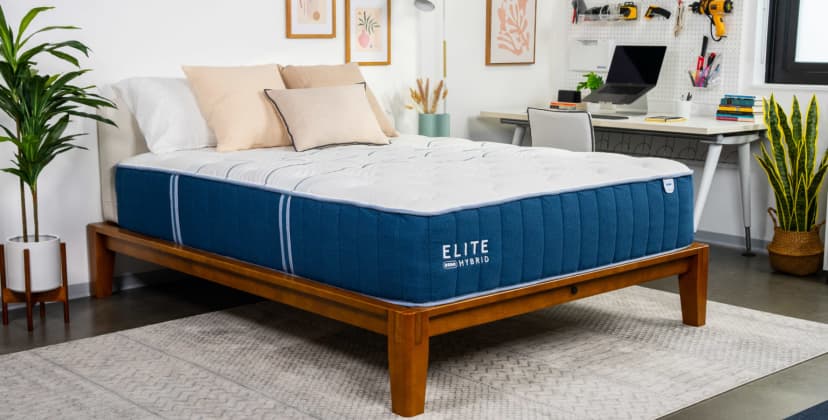
Credit: Sleep Foundation Test Lab
Price
$1,499
Mattress Type
Hybrid
Firmness Options
Medium (5), Medium Firm (6), Firm (8)
Trial Period
120 nights (30-night break-in period)
At a Glance
- Who It’s Best For: Individuals between 130 and 230 pounds and side sleepers of all weights.
- Feel: Plush, supportive, and relatively cool with good pressure relief.
- What It’s Made Of: A top layer of memory foam, a polyfoam transition layer, and zoned pocketed coil system. These rest on a polyfoam base and are encased in a polyester-blend cover. Also incorporates several cooling technologies.
- What We Don’t Like: Stomach sleeper’s midsection could sag, potentially putting pressure on the lower back.
Scoring & Reviews
The following ratings show how suitable this mattress is for different sleeping positions and sleeper weights. These scores are determined by how well the mattress supports and relieves pressure for each sleeper type.
We performed a meta-analysis on 3703 validated customer reviews of the Bear Elite Hybrid. This is what people who bought the mattress had to say:- Comfort and Support: Many reviewers highlight the mattress’s balance of comfort and support, often mentioning relief from back pain and improved sleep quality.
- Firmness Options: Customers appreciate the various firmness options, with some opting for firmer versions after experiencing discomfort with medium firmness.
- Temperature Regulation: Several reviews note the mattress’s ability to stay cool, which enhances sleep quality, especially in hot weather.
- Size and Upgrade Options: Customers are pleased with the availability of different sizes and the option to upgrade, which provides flexibility for different needs and preferences.
- Quality of Additional Products: Positive remarks on the quality of accompanying products like pillows and sheets, which are often included as free additions.
- Motion Isolation: Many reviewers highlight the mattress’s excellent motion isolation, making it ideal for shared sleeping arrangements.
Full Details
Bear produces a lineup of mattresses that cater to different sleep preferences and budgets. The Elite Hybrid has the thickest profile with foam layers that cushion along the spine to reduce pressure-induced pain.
How It Performs
Thanks to the multiple firmness options, this bed is suitable for a wide range of sleepers. Sleepers up to 230 pounds may find the softer models more comfortable, while those over 230 pounds will receive more support from the firmest model.
The medium firm and firm models offer strong edge support for sleepers who frequently sit on the edge or sleep close to it. If you experience painful pressure points and value a bed with strong contouring, you may benefit from the plushness of the medium firmness option.
Construction Breakdown
The mattress is available in three firmness levels — medium (5), medium firm (6), and firm (8). All models feature a quilted polyester cover made with Celliant fiber and phase change material, both of which are engineered to keep the surface cool.
Beneath is a layer of copper-infused memory foam that conforms closely to the body, followed by a polyfoam layer with a channeled design that helps air flow and enhances support to the lumbar region. The coil support core generates strong, even support throughout the mattress and along the perimeter.
Trial, Shipping & Warranty
Shipping is free to addresses in the contiguous U.S. Bear includes a 120-night sleep trial with this mattress, as well as a lifetime warranty.
Best Temperature-Regulating Mattress
Birch Mattress
8.8 /10
Test Lab Score
25% off sitewide
25% off sitewide
The Birch Mattress is a medium firm (6) latex hybrid model that incorporates natural materials. Organic wool and cotton enhance breathability to promote a cool, comfortable sleep environment. At the same time, the latex subtly cradles the sleeper to reduce pressure and tenderness without letting their body sag.
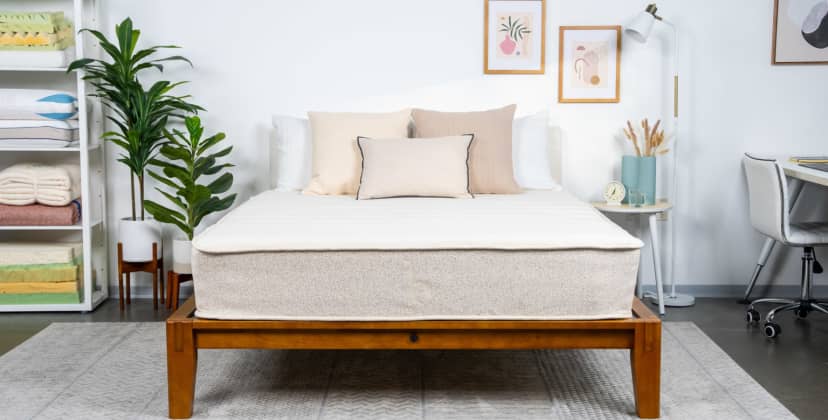
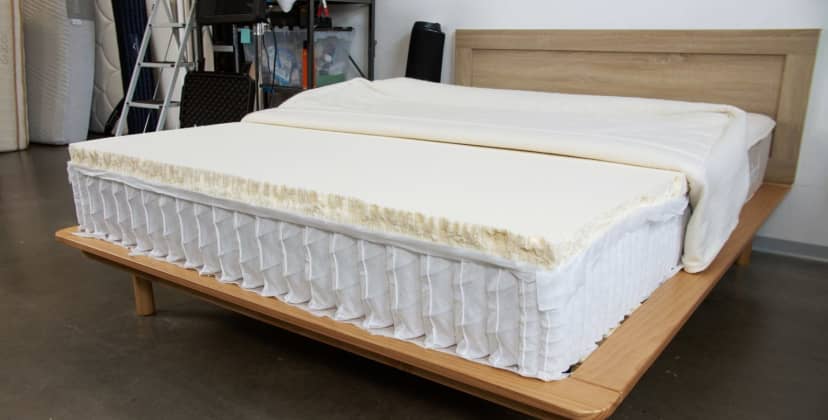
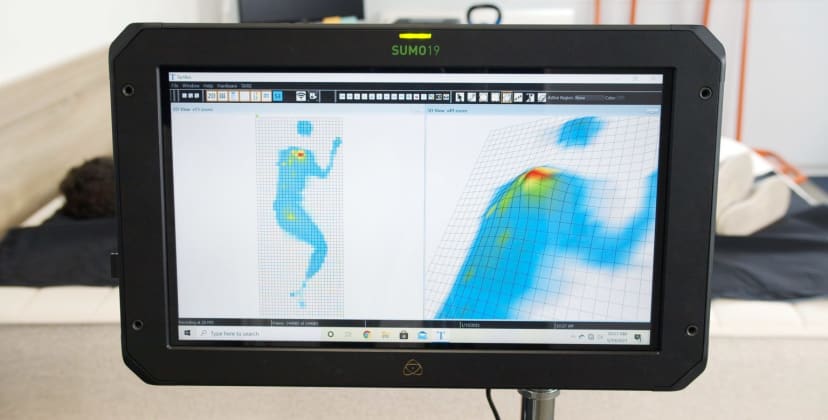

Credit: Sleep Foundation Test Lab
Price
$1,499
Mattress Type
Latex Hybrid
Firmness Options
Medium Firm (6)
Trial Period
120 nights (30-night requirement)
At a Glance
- Who It’s Best For: Hot sleepers and those over 130 pounds.
- Feel: Buoyant yet pressure relieving with a noticeably cool surface. Responsive latex and springy pocketed coils.
- What It’s Made Of: Organic cotton cover, organic wool layers, natural Talalay latex, and a pocketed coil core.
- What We Don’t Like: May notice motion transfer. Latex doesn’t conform like memory foam.
Scoring & Reviews
The following ratings show how suitable this mattress is for different sleeping positions and sleeper weights. These scores are determined by how well the mattress supports and relieves pressure for each sleeper type.
We performed a meta-analysis on 1917 validated customer reviews of the Birch Mattress. This is what people who bought the mattress had to say:- Comfort and Support: Many reviewers mention the mattress provides excellent support and comfort, particularly noting improvements in back and shoulder pain.
- Dual Firmness: The flippable design offering a choice between firm and soft sides is frequently appreciated, allowing users to customize their sleeping experience.
- Durability and Quality: Customers commend the high-quality, eco-friendly materials and construction, expressing satisfaction with the mattress’s durability and longevity. The use of organic and natural materials not only ensures comfort but also contributes to the mattress’s overall durability.
- Temperature Regulation: Customers appreciate the mattress’s ability to maintain a comfortable sleep temperature, attributing this to its natural and organic materials. The use of organic wool and natural latex contributes to effective temperature regulation, enhancing overall sleep quality. .
- Price: Opinions on the mattress’s price vary, with some finding it a good value and others considering it somewhat expensive.
- Weight and Maneuverability: The mattress is noted to be heavy, making it difficult to move or flip without assistance.
- Smell and Off-gassing: A few reviewers mention an initial off-gassing smell that dissipates over time.
- Edge Support: Mixed reviews on edge support, with some some noting it could be improved.
Full Details
Latex hybrids are often well suited to people with fibromyalgia because they provide gentle cradling to relieve pressure. The Birch Mattress is no exception, featuring airy Talalay latex that alleviates pain in pressure-prone areas. The Birch’s affordable price-point also makes it a good option for shoppers with limited budgets.
How It Performs
The Birch Mattress is a true medium firm (6) model, making it a solid pick for anyone in the range of 130 to 230 pounds regardless of their preferred sleep position. Side sleepers who weigh more and back and stomach sleepers who weigh less may also find the mattress comfortable.
Like many other latex hybrids, the Birch excels in temperature neutrality and sex. The combination of breathable materials like latex, cotton, and a coil support core regulates the core and the surface temperature.
Many couples should appreciate the responsive feel for sex, as well as the coil-reinforced perimeter. Couples can use the full surface of the bed without being confined to the middle, and they should have no trouble moving across the mattress surface.
Construction Breakdown
The mattress begins with two layers of organic wool batting, which serve as a natural fire barrier for the mattress and also have moisture-wicking properties to help you stay cool.
The comfort layer is composed of Talalay latex, a highly responsive material that contours to the body without hugging too closely – a common complaint about memory foam. The latex is ventilated to circulate air near the surface.
The support core contains pocketed coils that stabilize the mattress and promote additional airflow. The coils are reinforced along the perimeter, so the mattress shouldn’t sink too much when you sleep close to the edges or get in and out of bed. A cover made of GOTS-certified organic cotton encases the entire mattress.
Trial, Shipping & Warranty
All Birch Mattress purchases include free mattress-in-a-box shipping to customers in the contiguous U.S. and two Eco-Rest Pillows at no extra cost. The mattress comes with a 120-night sleep trial, and those who choose to keep it also receive a lifetime manufacturer’s warranty.
Best Soft Mattress
Turmerry Natural and Organic Latex Mattress – Soft
8.1 /10
Test Lab Score
$1,699 from Turmerry (queen)
$1,699 from Turmerry (queen)
The Turmerry Natural and Organic Latex Mattress is a plush latex model that offers gentle pressure relief. However, sleepers with fibromyalgia can adjust the mattress layers to customize the feel if their needs change over time. The model’s all-natural materials also let air circulate to dissipate heat.
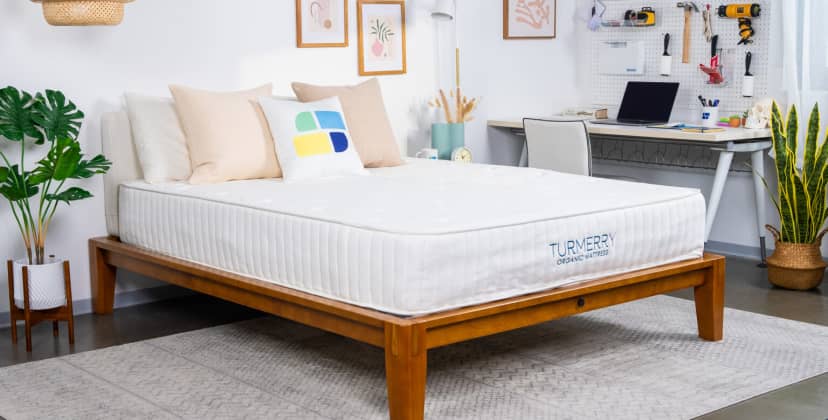
Credit: Sleep Foundation Test Lab
Price
$1,699
Mattress Type
Latex
Firmness Options
Soft (3)
Trial Period
120 nights
At a Glance
- Who It’s Best For: Eco-conscious side and back sleepers under 130 pounds.
- Feel: Plush and cool. Adjusts to the sleeper’s shape to limit pressure points, and allows good airflow.
- What It’s Made Of: Organic cotton, natural wool, and organic latex. You can reposition the latex layers to change the feel.
- What We Don’t Like: May not provide enough support for stomach sleepers. May also inhibit motion.
Scoring Breakdown
The following ratings show how suitable this mattress is for different sleeping positions and sleeper weights. These scores are determined by how well the mattress supports and relieves pressure for each sleeper type.
Full Details
Turmerry’s Natural and Organic Latex Mattress – Soft is a plush model that conforms closely for pressure relief while maintaining a buoyant quality. The mattress boasts GOTS and GOLS certifications, ensuring its materials were organically sourced and produced with environmental factors in mind.
How It Performs
One of the standout strengths of the Turmerry Natural and Organic Latex Mattress — Soft was pressure relief, given the overall soft (3) feel. Motion isolation was another pleasant surprise. Most latex beds allow a fair amount of motion transfer across the surface, but this model transferred less motion than other latex models we’ve tested, due to the plushness of the surface.
Our testers found the mattress best suited for side and back sleepers who weigh less than 130 pounds. If you prefer more supportive surfaces, the bed is available in firmer options. Temperature regulation was another strength. All the materials are naturally breathable, and our heat guns detected minimal heat retention during tests.
Construction Breakdown
Three profiles are available: 8, 10, and 12 inches. All models contain three to four layers (depending on the profile) of Dunlop latex that gently cradle the body and alleviate pressure in the joints and along the spine. This can help ease aches and pains for people who have fibromyalgia, while a sturdy support core reinforces the sleep surface and prevents you from sinking too deeply. The zoned design enhances cushioning and support where they’re most needed.
On top of the latex is a cotton layer and New Zealand wool batting that adds some surface cushioning while acting as a natural fire barrier. A breathable cover made from organic cotton encases the mattress.
Trial, Shipping & Warranty
Turmerry ships free to customers in the contiguous U.S. You can test the mattress and return it within 120 nights. The mattress is backed by a 20-year warranty.
Best Mattress and Adjustable Bed Set
Puffy Cloud Smart Bed Set
8.5 /10
Test Lab Score
$750 off + free accessories at Puffy
$750 off + free accessories at Puffy
The Puffy Cloud Smart Bed Set is a worthwhile option for sleepers with fibromyalgia who are in need of more position options. The mattress itself has a pressure-relieving, all-foam design to reduce common aches and pains, and the adjustable base lets sleepers change the position of their head and legs to find the most comfortable set up for them.

Price
$2,148
Mattress Type
Foam
Firmness Options
Medium (5)
Trial Period
101 Nights
At a Glance
- Who It’s Best For: Sleepers looking for extra comfort-related features.
- Feel: Medium (5) all-foam model. Along with a close, pressure-relieving hug, the adjustable base adds to the overall comfort and pressure relief.
- What It’s Made Of
- An all-foam mattress (memory foam and polyfoam encased in a polyester cover) and an adjustable base.
- What We Don’t Like: Too soft for most stomach and back sleepers over 230 pounds. Not available in twin or California king.
Scoring Breakdown
The following ratings show how suitable this mattress is for different sleeping positions and sleeper weights. These scores are determined by how well the mattress supports and relieves pressure for each sleeper type.
Full Details
Investing in a new mattress and adjustable bed can be daunting for anyone without an unlimited budget. With the Puffy Cloud Smart Bed Set, you get not only these two components but also a handful of bedding accessories — all at a decent sticker price.
The flagship Puffy Cloud Mattress has proven popular among side sleepers and people living with chronic pain, while the Serenity Adjustable Base offers a handful of features to enhance and optimize your sleep experience.
How It Performs
Our initial tests for the Puffy Cloud indicate the bed’s deep contouring and cushioning are ideal for side sleepers up to 230 pounds and back sleepers under 130 pounds.
Heavier individuals who use these positions and stomach sleepers may need a firmer, more supportive mattress to address their pain needs. Standout qualities we observed when testing the mattress include strong motion isolation and consistent pressure relief.
The Serenity Adjustable Base holds its own against the competition. We particularly enjoyed the zoned massage and extensive position options. If you’re a hot sleeper, the Puffy Sheet Set and Puffy Mattress Protector both provide great cooling and wick moisture away from your body. Puffy’s Signature Pillow offers adjustable firmness and loft, making it suitable for virtually any sleep position.
Construction Breakdown
The three-layer Cloud begins with 2 inches of adaptive memory foam that contours closely to create a soothing, pressure-relieving cradle for your entire body.
Denser transitional foam provides additional cushioning and keeps your body upright, while the high-density base foam provides good overall stability. This medium (5) mattress is encased in a stain-resistant cover that can be removed and machine-washed for easy cleaning.
Puffy’s Serenity Adjustable Base allows you to elevate your upper and lower body with a wide range of positions, including zero gravity. Other key features include zoned massage, under-bed lighting, and USB ports for charging your devices overnight.
Your order also comes with two shredded memory foam pillows, along with sheets and a mattress protector made of breathable bamboo-derived rayon. Twin, full, queen, king, and split king sizes are available.
Trial, Shipping & Warranty
Standard ground shipping is available to all 50 states. You can test out your Puffy Cloud Smart Bed Set for up to 101 nights, during which returns are allowed and full refunds are issued. Warranty terms vary by product.
- Pressure Relief: Memory foam and latex mattresses contour to the body and reduce pressure buildup around sensitive areas like the shoulders, hips, and lower back.
- Medium-Firm Feel: A medium-firm mattress often provides the best combination of support and comfort, helping maintain spinal alignment without causing excess pressure.
- Adaptive Support: Mattresses that offer zoned support systems can be particularly helpful, providing extra cushioning where it’s needed most and firmer support where it’s required to promote spinal alignment.
- Temperature Regulation: Poor temperature regulation can worsen fibromyalgia symptoms. Mattresses with breathable materials, cooling gel infusions, or open-cell foam structures can help maintain a comfortable sleep environment.
How We Evaluated & Reviewed
Meta Analysis: We narrowed down the 2,000+ mattresses in our product database to roughly 600 models that were either medium-firm or exceptionally pressure relieving. Then, using historical testing data and construction analyses, our team chose the top 40 for additional in-depth evaluations.
Hands-On Testing: In our Seattle Sleep Lab, we had testers lie on each of the top 40 bed and measure how deeply a mattress compresses and how long it takes to return to its original shape. We also used pressure pad mapping technology and a heat gun to test for pressure relief and temperature regulation, respectively.
Field Testing: Once we finished our lab tests, we sent each bed home with a member of our testing team to sleep on for up to two weeks to gauge how a mattress performs in real-world sleep environment.
User Reviews: We collected data from more than 24,000 verified customer reviews to determine whether our team’s findings match real-world experiences.
The Best Deals of the Week
-
Save $199
—
Brooklyn Bedding CopperFlex Memory Foam
$466 (List Price $665) -
Save $600
—
Helix Midnight Luxe
$1,799 (List Price $2,399) -
Save $2,436
—
Nectar Adjustable Bundle
$1,398 (List Price $3,834) -
Save $771
—
WinkBed
$1,799 (List Price $2,570) -
Save $1,020
—
DreamCloud Classic Hybrid
$699 (List Price $1,719)
Best Overall Mattress
Helix Midnight Luxe
9.7 /10
Test Lab Score
25% off sitewide
Shop at HelixBalanced cushioning and support to ease fibromyalgia discomfort.
See More Details
Best Value Mattress
Brooklyn Bedding CopperFlex Memory Foam
8.6 /10
Test Lab Score
30% off sitewide
Shop at Brooklyn BeddingNotable pressure relief and temperature control at an approachable price-point.
See More Details

Credit: Sleep Foundation Test Lab
Most Comfortable Mattress
Luxury Firm WinkBed
9.5 /10
Test Lab Score
Get $300 off all mattresses at Winkbeds
Shop at WinkBedsWell-rounded cushioning, support, and breathability to relieve discomfort without trapping heat.
See More Details
Best Mattress for Side Sleepers
Leesa Sapira Chill Hybrid
9.0 /10
Test Lab Score
25% off sitewide
Shop at LeesaTargeted support, gentle cushioning, and excellent thermoregulation for sleeping more comfortably with fibromyalgia.
See More Details
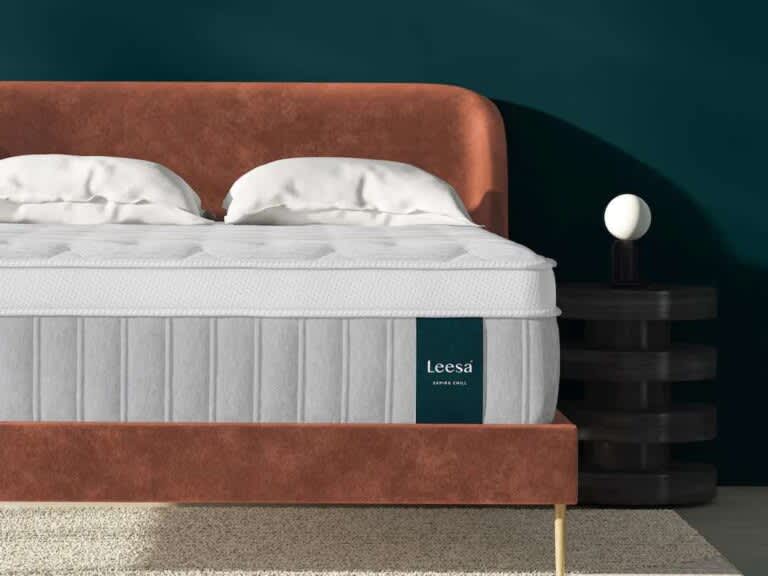
Best Luxury Mattress
Saatva Rx
8.5 /10
Test Lab Score
$300 off orders of $1,000 or more
Shop at SaatvaA high-end luxury bed designed specifically for sleepers with chronic pain.
See More Details
Best Mattress for Pressure Relief
Nolah Evolution 15
9.2 /10
Test Lab Score
35% off sitewide + extra $100 off with code: SF100
Shop at NolahA thick comfort system and three firmness options for pressure relief regardless of sleep position and body type.
See More Details
Best Mattress for Back Pain
Bear Elite Hybrid
8.5 /10
Test Lab Score
40% sitewide with code: SF40
Shop at BearAdvanced pressure relief and temperature control technology make this bed a top choice for sleepers experiencing chronic pain.
See More Details
Best Temperature-Regulating Mattress
Birch Mattress
8.8 /10
Test Lab Score
25% off sitewide
Shop at BirchNatural materials with a hybrid design for exceptional support, pain relief, and breathability.
See More Details
Best Soft Mattress
Turmerry Natural and Organic Latex Mattress – Soft
8.1 /10
Test Lab Score
$1,699 from Turmerry (queen)
Shop at TurmerryPlush, customizable, all-natural comfort that can adjust to changing needs.
See More Details
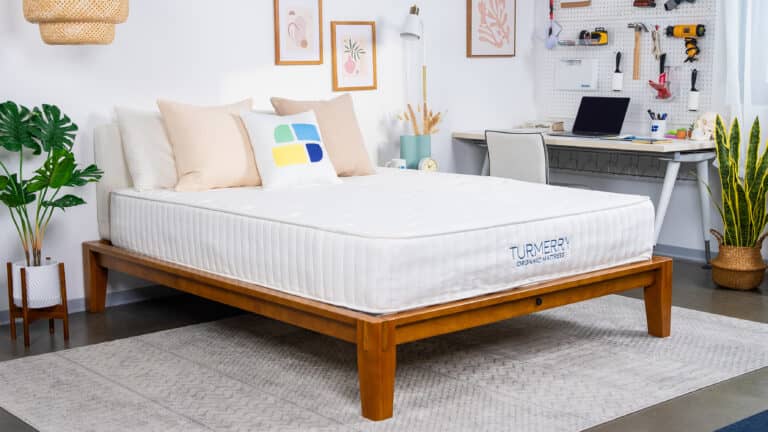
Credit: Sleep Foundation Test Lab
Best Mattress and Adjustable Bed Set
Puffy Cloud Smart Bed Set
8.5 /10
Test Lab Score
$750 off + free accessories at Puffy
Shop at PuffyA convenient set combining an adjustable base and a foam mattress for easy angle adjustments.
See More Details
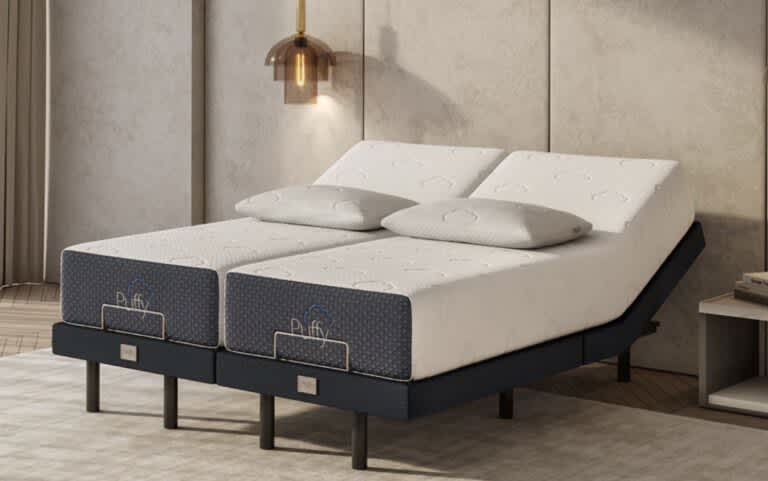
Compare the Best Mattresses for Fibromyalgia
Select up to 3 products to compare
|
Rating
|
Product |
Price |
|
|---|---|---|---|
|
/10 |
$1,799 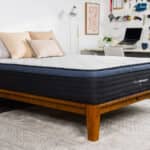
|
||
|
/10 |
$466 
|
||
|
/10 |
$2,570 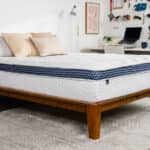
|
||
|
/10 |
$1,698 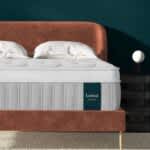
|
||
|
/10 |
$2,801 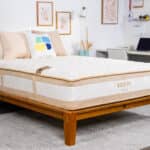
|
||
|
/10 |
$1,624 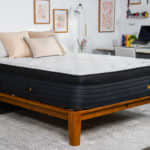
|
||
|
/10 |
$1,499 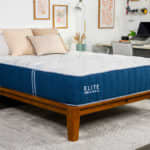
|
||
|
/10 |
$1,499 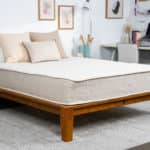
|
||
|
/10 |
$1,699 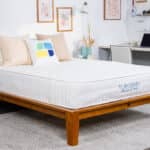
|
||
|
/10 |
$2,148 
|
Compare Mattresses
Go back to select different products
Price
$1,799
$466
$2,570
$1,698
$2,801
$1,624
$1,499
$1,499
$1,699
$2,148
Mattress Type
Hybrid
Foam
Innerspring
Hybrid
Hybrid
Hybrid
Hybrid
Latex Hybrid
Latex
Foam
Firmness Options
Medium Firm (6)
Medium Firm (6)
Medium Firm (6)
Medium (5), Medium Firm (6), Firm (7)
Medium Soft (4)
Medium (5), Medium Firm (6), Firm (8)
Medium (5), Medium Firm (6), Firm (8)
Medium Firm (6)
Soft (3)
Medium (5)
Customer Rating
9.0/10
0.0/10
9.6/10
8.0/10
9.8/10
9.8/10
9.4/10
9.4/10
9.6/10
10.0/10
Side Sleepers (Under 130 lbs.)
9.5/10
7.0/10
9.5/10
9.0/10
9.0/10
9.0/10
8.5/10
7.5/10
8.5/10
9.5/10
Side Sleepers (130-230 lbs.)
10.0/10
9.0/10
10.0/10
9.5/10
7.5/10
9.5/10
9.0/10
8.0/10
7.5/10
9.0/10
Side Sleepers (Above 230 lbs.)
9.5/10
7.5/10
9.5/10
9.0/10
6.5/10
9.0/10
8.5/10
7.5/10
6.0/10
8.0/10
Back Sleepers (Under 130 lbs.)
8.5/10
8.0/10
8.5/10
8.0/10
7.5/10
8.0/10
7.5/10
9.0/10
8.0/10
7.5/10
Back Sleepers (130-230 lbs.)
8.0/10
7.0/10
8.0/10
7.5/10
7.0/10
7.5/10
7.0/10
8.5/10
7.0/10
6.5/10
Back Sleepers (Above 230 lbs.)
8.0/10
7.0/10
8.0/10
7.5/10
7.0/10
7.5/10
7.0/10
8.5/10
7.0/10
6.5/10
Stomach Sleepers (Under 130 lbs.)
8.5/10
8.0/10
8.5/10
8.0/10
7.5/10
8.0/10
7.5/10
9.0/10
6.5/10
6.5/10
Stomach Sleepers (130-230 lbs.)
7.5/10
6.0/10
7.5/10
7.0/10
7.0/10
7.0/10
6.5/10
8.0/10
5.5/10
6.0/10
Stomach Sleepers (Above 230 lbs.)
6.5/10
5.5/10
6.5/10
6.0/10
6.5/10
6.0/10
5.5/10
7.0/10
4.0/10
5.5/10
Motion Isolation
8.5/10
8.5/10
6.5/10
7.5/10
8.0/10
8.0/10
7.0/10
6.0/10
7.0/10
9.0/10
Edge Support
9.5/10
7.0/10
9.5/10
7.0/10
7.0/10
9.0/10
7.5/10
8.5/10
6.5/10
7.0/10
Temperature Control
8.0/10
7.0/10
9.0/10
7.5/10
8.0/10
7.5/10
7.0/10
8.5/10
7.5/10
6.0/10
Ease of Movement
7.5/10
6.5/10
7.5/10
8.0/10
7.0/10
7.0/10
6.5/10
8.5/10
7.0/10
6.0/10
Off-gassing
8.0/10
6.0/10
9.5/10
7.5/10
8.0/10
7.5/10
7.0/10
8.5/10
8.0/10
6.5/10
Pressure Relief
9.5/10
9.0/10
8.0/10
8.5/10
8.0/10
9.0/10
8.0/10
6.5/10
8.0/10
8.5/10
Product Review
Video: Best Mattresses for Fibromyalgia
Watch the video below to learn more about our top mattress picks for sleepers with fibromyalgia.
What Is Fibromyalgia and How Does It Affect Sleep?
The symptoms of fibromyalgia can impair sleep in several different ways. Widespread pain is one of the most common symptoms associated with fibromyalgia. As with any condition that causes pain, fibromyalgia may make it more difficult to fall asleep and/or stay asleep. Temperature sensitivity is also common with the condition and can make it hard to get comfortable.
“The mechanisms leading to fibromyalgia are an area of active research, but the exact cause remains unknown,” says Dr. Wells. “Both genetic and environmental factors are thought to contribute to one’s susceptibility to the condition. Fibromyalgia is understood to result from nervous system dysregulation, which heightens pain sensitivity, disrupts sleep, and causes fatigue—symptoms that perpetuate and intensify one another.”
Sleep problems are a common concern for people with fibromyalgia. You may experience insomnia, disruptive sleep, or simply a lack of restorative sleep. Further exacerbating the issue, people with fibromyalgia also frequently suffer from other disorders that can interrupt sleep, like sleep apnea and restless leg syndrome. With so many symptoms that can impact sleep, it should come as no surprise that many people with fibromyalgia also experience daytime fatigue.
While mattresses can’t relieve all the symptoms associated with fibromyalgia, the right mattress can help people with fibromyalgia get more restful sleep by limiting other factors that could interrupt sleep. Heat retention, motion transfer, noise, lack of support, and pressure buildup all interfere with sleep, and the right mattress can help minimize these.
“Sleep and pain have a bidirectional relationship, and the current data suggest that the effects of sleep on pain are likely stronger than the effects of pain on sleep. Focusing on improving your sleep quality may help with your overall pain level. Common changes to sleep quality could include difficulty falling and/or staying asleep, more sleep fragmentation (i.e., more awakenings during the night), early morning awakenings, and unrefreshing/non-restorative sleep.”
– Sarah Silverman, Psy.D., a licensed psychologist and holistic sleep wellness consultant who treats patients in New York and Florida.
How Does Sleep Position Affect People With Fibromyalgia?
Your sleeping position can directly impact the pain you experience with fibromyalgia. Each position has certain potential benefits and drawbacks. It’s common to select your sleep position based on your current aches and pains, but that sleep position could have unforeseen consequences. Picking a mattress that promotes healthy sleep posture is important for all sleepers, but even more so for people with fibromyalgia.
Back Sleepers
Many people with fibromyalgia find it comfortable to sleep on their backs because it can reduce lower back pain. Back sleepers tend to prefer a slightly firmer mattress that doesn’t let their hips sink in too far. If you do experience more pain while on your back, try placing a pillow under your knees.
Back sleeping can be more problematic for people with fibromyalgia who also snore or have sleep apnea since this position can worsen symptoms, but propping up the upper body with a wedge pillow may help.
Side Sleepers
Side sleepers tend to experience pressure at the shoulders and hips because these spots are heavier. As with any sleep position, finding the right mattress firmness is critical. Those with fibromyalgia tend to prefer a mattress that’s on the softer side and cradles their curves to reduce pressure buildup and support spinal alignment. Just don’t go too soft, or your hips and shoulders might sink too far, pulling your spine out of alignment.
Since side sleepers’ legs rest on top of each other, any side sleeper could also experience hip and knee discomfort, but this may be more pronounced for people with fibromyalgia. Placing the pillow between your knees or hugging a body pillow can make the position more comfortable.
Stomach Sleepers
Sleeping on your stomach can strain the spine and neck, so it generally isn’t advisable. However, many people with fibromyalgia may choose to sleep in whichever position feels the best that night.
The bulk of a person’s weight is usually centered around a person’s belly and hips. If you sleep on your stomach, this weight can pull your midsection into the mattress and put a strain on the lumbar region. Stomach sleepers also generally turn their heads to the side, which may lead to neck strain. A thick pillow could further exacerbate this neck strain by forcing it to extend backward.
If you frequently sleep on your stomach, there are ways to help limit strain and discomfort. A firmer mattress will provide better midsection support and promote better spinal alignment. Many stomach sleepers also choose to use no pillow or a very thin pillow to reduce neck strain. Stomach sleepers might also transition away from the position by using a body pillow to prop themselves onto their sides.
Combination Sleepers
Alternating between multiple sleep positions may help those with fibromyalgia sleep more comfortably by switching which body parts experience pressure. Combination sleepers will experience the pros and cons of each sleep position they choose, but switching positions through the night will likely minimize any negative impacts.
“For people with fibromyalgia,” says Dr. Wells, “I validate that living with chronic pain is hard. So prioritizing comfort isn’t just about feeling good – it’s about managing pain and promoting restorative sleep so you can make a meaningful difference in improving daily resilience.”
What Type of Mattress Is Best for Fibromyalgia?
Most mattress models can be classified as one of five main types: hybrid, innerspring, latex, airbed, or foam. Performance varies between individual models because of their unique materials, quality, and construction techniques, but mattresses within the same category tend to share some similarities.
Hybrid
Definition: Hybrid mattresses use a combination of two or more materials. The support core is constructed of coils, while the top comfort layer may include memory foam, polyfoam, latex, microcoils, and/or other materials.
Highlight: Contouring and breathability. People with fibromyalgia may prefer a model with good contouring to help relieve their pressure points. However, close conforming can also trap heat. The comfort layers of most hybrid models cradle the sleeper to relieve pressure, while their coil cores tend to allow significant airflow for heat to dissipate.
Innerspring
Definition: The main feature of an innerspring model is its coil system. This layer makes up the bulk of the mattress, though some models also include thin comfort layers.
Highlight: Responsiveness. Innerspring models usually have a springy feel that makes it easier to move on the bed. People who frequently change positions due to their fibromyalgia pain may like the responsive feel of most innerspring models, though there might not be enough cushioning to ease aches and pains.
Latex
Definition: Made from the sap of rubber trees, natural latex foam can be fabricated using either the Talalay or Dunlop process. Talalay is usually springier and more breathable, while Dunlop tends to be denser and more durable. Some models also use synthetic or blended latex.
Highlight: Weightless pressure relief. The low point elasticity of latex means that it compresses over a wider area when weight is applied. This redistributes the sleeper’s weight to relieve pressure buildup with what many sleepers liken to a floating sensation. People with fibromyalgia who like pressure relief without a lot of hug may find latex models ideal.
Airbed
Definition: Airbeds use air chambers as their support system. Depending on the model, the sleeper can fill or empty the chambers using a remote, an app, or a crank. Some airbeds also have thin comfort layers to soften the surface of the mattress.
Highlight: Adjustability. Emptying or filling an airbed’s chambers adjusts the firmness of the sleep surface. Since fibromyalgia symptoms can change over time, this adjustability may give individuals more flexibility to cater their sleep surface to meet their current needs, even if they change every night.
Foam
Definition: Foam models may include multiple types of foam, including memory foam and polyfoam. Memory foam, known for its deep contouring, is most often used in the comfort and/or transition layer, while polyfoam, which is springier, may be used in any layer but is most common in the support core.
Highlight: Pressure relief and motion isolation. All-foam models usually conform closely to the sleeper’s body to reduce pressure buildup around the shoulders and hips. They also tend to absorb motion, which reduces the vibrations a sleeper feels when their partner moves. Individuals who awaken easily or experience pains as a result of their fibromyalgia may like this combination of pressure relief and motion isolation.
What to Look for in a Mattress for Fibromyalgia
When purchasing a mattress, shoppers should take into account the things that are most likely to impact their sleep. For many individuals, sleep position and weight are the biggest factors, but people with fibromyalgia should also consider their symptoms. In this section, we’ll highlight some of the most important things to examine when selecting a mattress.
Firmness and Support
A mattress’s firmness influences how much contouring and support an individual will experience. The right firmness is key for people with fibromyalgia to ensure they enjoy the best balance of contouring and support. Models that are too soft may not support the sleeper’s natural spinal alignment, while mattresses that are too firm could contribute to pressure buildup. The ideal firmness varies based on an individual’s weight, sleep position, and personal preferences. As a general rule, lighter individuals usually prefer softer models and heavier individuals generally favor firmer models.
Pressure Relief and Contouring
When an individual lies down, their wider, heavier body parts generally put more force on the mattress. On some mattresses, this could lead to pressure buildup. Any sleeper could experience aches and pains as a result of pressure points. However, since people with fibromyalgia usually already experience significant pain, added discomfort could be more problematic for them. Aim for a mattress with a significant amount of contouring to ease pressure points.
Price
Price is one of the main deciding factors for most people in their mattress purchase. While cheap mattress options are appealing, higher-priced models may also be a good value. Higher sticker prices typically reflect quality materials and durable builds. You’re likely to find a mattress that works for you in most price ranges,, but you might also want to set money aside for mattress accessories. Those with fibromyalgia may enjoy a mattress topper for extra cushioning, breathable sheets for more temperature regulation, and/or additional pillows to accommodate changing aches and pains.
Quality Materials
High-quality materials often make a mattress more expensive, but they can have distinct advantages. Some materials are specially engineered to regulate temperatures, relieve pressure points, and/or support proper spinal alignment. Quality materials also frequently last longer than lower-quality materials.
Edge Support
A sturdy edge can make it easier to use the full surface of the mattress. This may be important to couples who want the extra space that sleeping close to the perimeter of the bed affords. People with fibromyalgia whose pains make it harder to get into or out of bed may also prefer a strong perimeter so that they can sit near the edge of the bed without it feeling unstable.
Temperature Regulation
People with fibromyalgia are often sensitive to temperature. Some mattress models trap heat, which could make a comfortable night’s sleep more challenging. Memory foam is usually most associated with heat retention, but many memory foam models use special materials and construction techniques to keep the sleep surface cooler. Innerspring, hybrid, and latex models tend to be breathable, which allows heat to dissipate away from the sleeper’s body.
Ease of Movement
People with fibromyalgia may change positions throughout the night in order to find the most comfortable sleep position. Some mattresses are easier to move on than others, so those with mobility issues may prefer a model that rates well for ease of movement. Memory foam often hugs closely to the sleeper’s body and usually responds relatively slowly to changes in pressure, which could contribute to a “trapped in the bed” feel. Mattresses that use foams engineered for responsiveness, latex, and/or coils are usually easier to move on.
Warranty, Sleep Trial, and Shipping
Mattresses generally come with a warranty that protects against certain defects. Understanding what’s covered, how long the coverage lasts, and what you need to do to ensure you don’t void the policy may give you a better idea of what to expect.
Direct-to-consumer mattresses also typically come with a sleep trial during which customers can try the mattress at home and return it if they are not satisfied. People with fibromyalgia may prefer a mattress with a generous trial period so that they can see how the mattress performs with their symptoms.
Shipping policies may also be worth considering. If your fibromyalgia pain would make it difficult for you to move the mattress to your room of choice and unpack it, you may wish to look for a company that offers White Glove delivery.
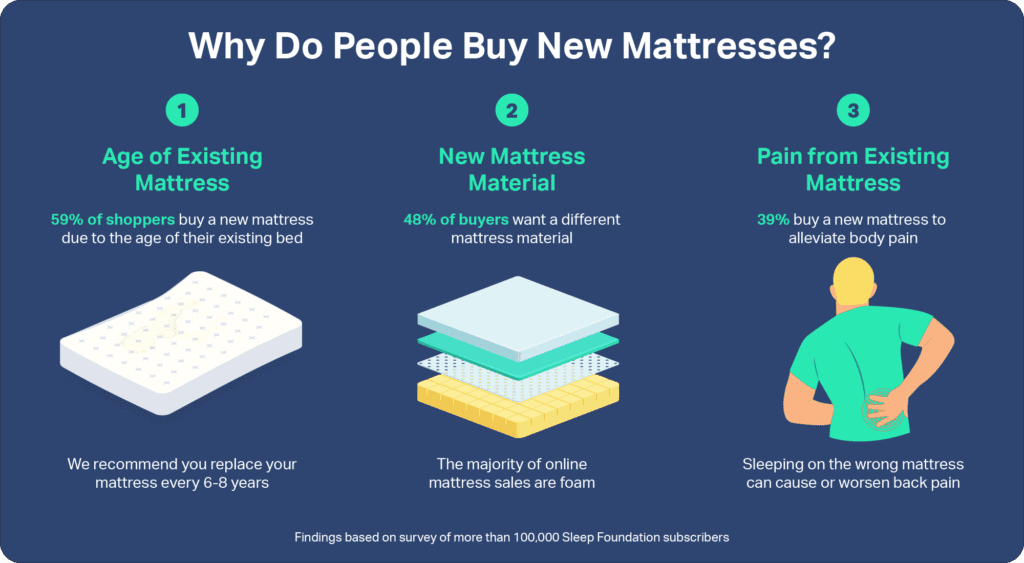
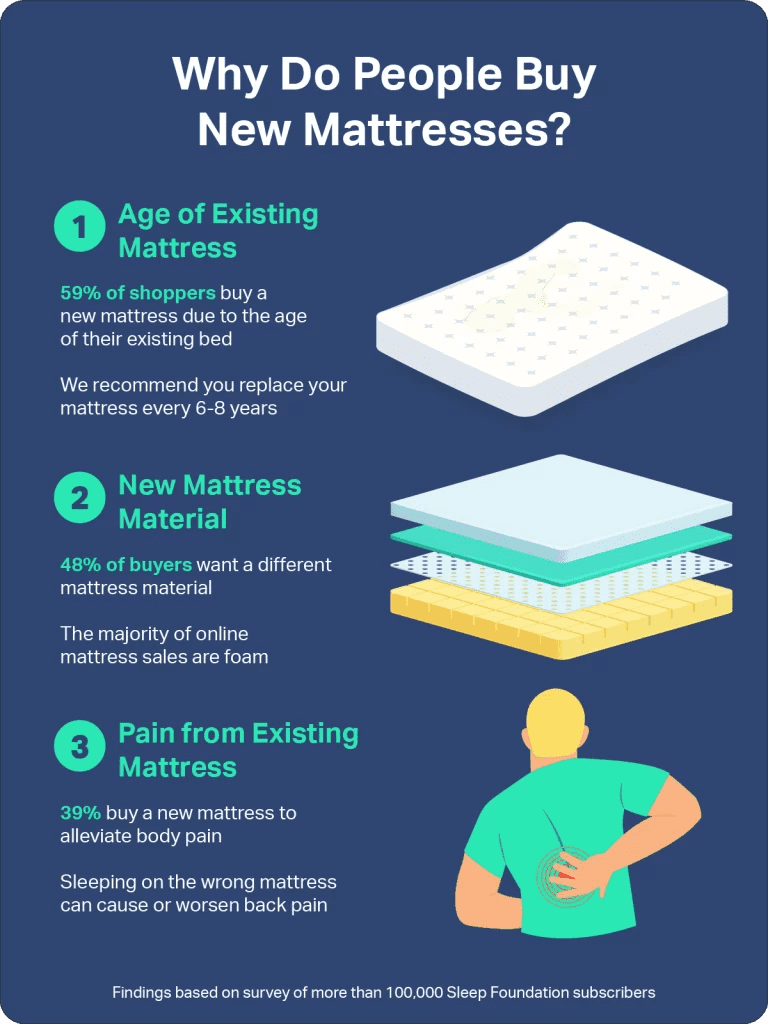
Tips for Relieving Fibromyalgia Pain During Sleep
While finding the right mattress is an excellent step toward getting better sleep with fibromyalgia, there are other steps you can take to help alleviate pain and discomfort at night.
Talk to Your Doctor
According to Dr. Wells, sleep often represents a “blind spot” in care when it comes to chronic pain conditions. “Especially for those with fibromyalgia,” she says, “it’s important to discuss all of your sleep and wake symptoms with your doctor. Restless legs syndrome and sleep apnea commonly coexist with fibromyalgia, so ruling out these diagnoses or treating them effectively is important. Cognitive behavioral therapy for insomnia (CBT-I) can also offer tools that help with managing chronic pain.”
Focus on Temperature Control
If you experience temperature sensitivity with your fibromyalgia, focus on temperature control for a more comfortable sleep environment. Consider investing in a cooling pillow or sleepwear, breathable sheets, and/or a fan.
“Cold hands and feet can interfere with getting to sleep,” says Dr. Wells. “Instead of warming the whole bedroom or layering on blankets, consider applying heat locally with a heating pad or microwavable rice pouch.”
Invest in a Mattress Topper and Pillows
Those who have aches and pains may like a mattress topper for extra cushioning and/or a selection of pillows to give them more options. While a mattress topper can’t fix an unsupportive mattress, it can make a difference if your mattress could use a little more contouring.
Try a variety of pillows depending on how your body feels each night. You might appreciate a higher loft pillow if sleeping on your side feels best or no pillow at all if you want to sleep on your stomach. A pillow under your knees can help your lower back, and a body pillow can be moved around depending on where you need extra cushioning.
How We Test: Your Comfort Is Our Science
Our industry-leading product testing team cares deeply about improving your sleep. Having a holistic understanding of a mattress’s role as part of a sleep system is paramount to our testing process. Since a bed’s comfort and feel depend largely on body weight and sleeping position, our testing team represents a wide range of body types, sleep positions, and comfort preferences.
In our Seattle-based Test Lab, we use an objective, hands-on process to evaluate mattresses across performance categories. The following are the key guidelines that inform our performance ratings. Our ultimate goal is to ensure you have all the information you need to make the best purchase decision for you.
Construction analysis: We begin by examining each mattress in terms of its design, making note of manufacturer specifications such as firmness and height. From there, we perform a detailed analysis to determine how materials and individual layers impact the bed’s ability to alleviate pressure, isolation motion, regulate temperature, and support your body.
Product testing: Using a slew of tools and tech resources, our team tests each mattress for performance in six individual categories. These tests also involve us lying on the mattress to gauge how comfortable and supportive it feels for different body types and sleep positions.
Field testing: In addition to our lab-based tests, we calculate ratings for mattresses based on feedback from field testers who use mattresses in their own homes. These testers provide data based on their experience with each bed over the course of several weeks.
User testing: Feedback from verified mattress owners also plays a role in our evaluation process. We collect data from surveys and product reviews to ensure our mattress ratings reflect real-world experiences.
How We Determine Our Overall Scores

To determine a mattress’s overall score, we assign weighted percentages to performance categories based on how important they are to the individual sleep experience. For instance, areas like pressure relief and temperature control tend to matter more to people than something like off-gassing, and because more people sleep on their side and back than on their stomach, we weigh those positions more heavily.
Performance Categories
Motion Isolation
This criteria alludes to the amount of motion a mattress absorbs when a sleeper moves on the surface. We use two testers lying side by side to evaluate motion isolation, who each feel for transfer while the other person moves on the mattress.
Temperature Control
To determine how well a mattress regulates temperature, we perform temperature tests and look closely at its materials and construction. Many mattresses are designed with cooling components meant to reduce heat retention.
Pressure Relief
A bed with strong pressure relief excels at preventing pressure from building up in areas like the shoulders and hips. Beds with even contouring and weight distribution are top performers when it comes to pressure relief.
Off-Gassing
A mattress in a box may release unpleasant chemical odors for a short period after you’ve unboxed it. The initial smell may be strong but typically fades within 2 or 3 days.
Ease of Movement
This criteria reflects how easily a sleeper can move across a bed’s surface. Responsive surfaces made of latex typically perform better than foam surfaces, which can inhibit movement.
Edge Support
We perform sit tests along a bed’s perimeter to measure how well the edges push back against weight. Mattresses with strong edge support have minimal sagging when sleepers sit on or lie close to the perimeter.
Dive Deeper — Mattress Guides by Purpose
For more help finding a mattress that checks all of your boxes, take a look at our recommendations broken down by mattresses for particular uses.
Best Mattress by Specific Purpose

Still have questions? Ask our community!
Join our Sleep Care Community — a trusted hub of product specialists, sleep health professionals, and people just like you. Whether you’re searching for the perfect mattress or need expert sleep advice, we’ve got you covered. Get personalized guidance from the experts who know sleep best.
